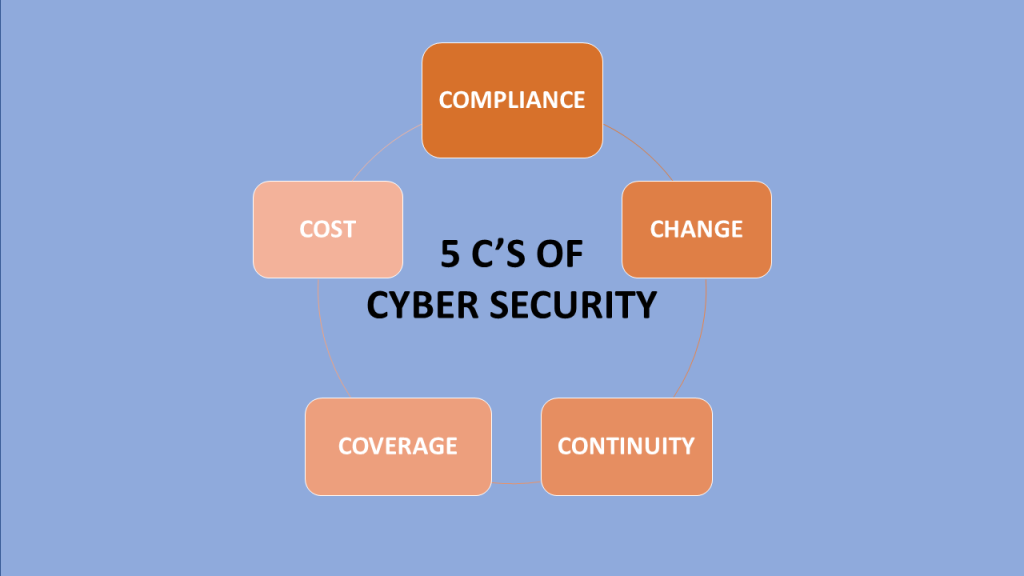In today’s increasingly digital world, cybersecurity has become a top priority for businesses of all sizes. The rise in cyberattacks, data breaches, and online threats means that safeguarding sensitive information and digital assets is more critical than ever. One way to structure an effective cybersecurity strategy is by focusing on the 5 C’s of Cybersecurity.
These core principles—Change, Compliance, Cost, Continuity, and Coverage—provide a comprehensive framework for businesses to assess, manage, and improve their cybersecurity posture.
In this guide, Creative Networks breaks down each of the 5 C’s, explaining their importance and offering practical insights into how your business can implement them to create a robust cybersecurity strategy.

1. Change
In the fast-evolving world of technology, the first “C” of cybersecurity is Change. Cyber threats are constantly evolving, as hackers develop new techniques and tools to bypass security measures. This means that businesses must stay agile, regularly updating their security practices, systems, and technologies to keep up with emerging threats.
Why Change is Important
The dynamic nature of the cyber threat landscape means that no security solution is ever permanent. A firewall that protects your network today might be ineffective against a new malware strain tomorrow. For this reason, staying current with software updates, security patches, and threat intelligence is essential. According to a 2023 cybersecurity report, 60% of businesses that experienced a data breach had outdated security software, underscoring the importance of maintaining updated systems.
How to Implement Change
- Regular Updates: Ensure all software, operating systems, and antivirus tools are updated regularly. Apply patches as soon as they are available to mitigate potential vulnerabilities.
- Monitor Threat Landscape: Stay informed about the latest cyber threats by following security advisories and engaging with cybersecurity communities.
- Flexible Security Policies: Regularly review and update your internal security policies to ensure they reflect the latest best practices and cover emerging risks.
2. Compliance
The second “C” stands for Compliance, which refers to adhering to the relevant legal, regulatory, and industry-specific cybersecurity standards. Compliance is crucial not only for avoiding fines and legal repercussions but also for building trust with customers and partners. Regulations such as the GDPR (General Data Protection Regulation) and HIPAA (Health Insurance Portability and Accountability Act) place strict requirements on how businesses handle, store, and protect personal data.
Why Compliance is Important
Non-compliance with cybersecurity regulations can lead to severe penalties, reputational damage, and even the loss of customers. For example, businesses that fail to comply with GDPR face fines of up to €20 million or 4% of their global turnover, whichever is higher. Additionally, following industry standards like ISO/IEC 27001 can significantly enhance your business’s reputation, as customers and partners are more likely to trust companies that take cybersecurity seriously.
How to Achieve Compliance
- Understand the Regulations: Identify which data protection regulations and industry standards apply to your business. For example, GDPR applies to businesses handling the personal data of EU citizens, while HIPAA is relevant for healthcare providers.
- Conduct Regular Audits: Carry out regular security audits to ensure your systems are compliant with the latest regulations. This includes reviewing data storage, access controls, and encryption practices.
- Implement Compliance Tools: Use compliance management tools to track and manage your adherence to relevant regulations. These tools can automate audits, track changes, and provide updates on compliance status.
3. Cost
The third “C” is Cost, and it refers to the financial considerations involved in implementing and maintaining cybersecurity measures. While it’s tempting to view cybersecurity as an expensive overhead, the reality is that the cost of a cyberattack far outweighs the cost of preventive measures. For example, a 2023 study showed that the average cost of a data breach is around $4.35 million, highlighting the financial impact of inadequate security.
Why Cost is Important
Investing in cybersecurity should be seen as an essential part of running a modern business, not an optional expense. Failing to invest adequately can lead to devastating financial consequences, including lost revenue, legal costs, and reputational damage. However, businesses also need to be strategic about where they allocate their cybersecurity budget to ensure that they are getting the most value for their investment.
How to Manage Cybersecurity Costs
- Prioritize Critical Assets: Identify and protect your business’s most critical digital assets, such as customer data, intellectual property, and financial information. This will help you allocate resources effectively.
- Invest in Scalable Solutions: Choose cybersecurity tools and platforms that can scale as your business grows, ensuring that your investment today will continue to provide value in the future.
- Consider Outsourcing: For small and medium-sized businesses, outsourcing cybersecurity to a Managed Security Service Provider (MSSP) can provide robust security without the high cost of building an in-house team.
4. Continuity
The fourth “C” refers to Continuity, which focuses on ensuring that your business can continue operating even in the event of a cyberattack. Cyber resilience is a critical component of any cybersecurity strategy, as it helps minimize downtime, protect critical operations, and recover quickly from incidents.
Why Continuity is Important
Cyberattacks like ransomware can disrupt your business operations for days, weeks, or even longer. For instance, a ransomware attack can lock your systems, halting critical business processes and potentially costing thousands or even millions in lost revenue. A well-structured business continuity plan can mitigate these risks by ensuring your organization has protocols in place to maintain essential operations and restore systems in the event of an attack.
How to Ensure Continuity
- Develop a Business Continuity Plan (BCP): Outline steps for maintaining operations during a cyber incident, including backup protocols, emergency contacts, and a recovery timeline.
- Implement Regular Backups: Ensure your data is backed up regularly, both onsite and in the cloud. Backups should be encrypted and stored in a secure location to prevent loss or tampering.
- Test Incident Response Plans: Regularly simulate cyberattacks and test your incident response plans to identify gaps and improve your organization’s ability to recover quickly from disruptions.
5. Coverage
The final “C” stands for Coverage, which refers to ensuring that your cybersecurity efforts encompass all aspects of your business, from internal systems and devices to third-party vendors and cloud services. Comprehensive coverage is essential because attackers often target the weakest link in your security chain, which could be an overlooked area like mobile devices or a third-party vendor.
Why Coverage is Important
Cyber threats can come from multiple vectors, including insider threats, phishing attacks, unsecured mobile devices, and poorly secured third-party applications. In fact, 63% of data breaches in 2022 were linked to vulnerabilities within third-party vendors. Ensuring full coverage protects not just your core systems but also external touchpoints that could expose your business to attacks.
How to Achieve Comprehensive Coverage
- Conduct a Risk Assessment: Regularly assess all areas of your business to identify vulnerabilities and potential risks. This includes reviewing networks, devices, cloud storage, and vendor relationships.
- Implement Multi-Factor Authentication (MFA): Strengthen security by requiring multi-factor authentication for all users accessing sensitive data or systems, particularly when using remote access.
- Secure Third-Party Access: Ensure that third-party vendors comply with your security standards by requiring them to implement robust security measures. Consider conducting security audits on key partners.
Strengthening Cybersecurity Through the 5 C’s
In an era where cyberattacks are becoming more frequent and sophisticated, the 5 C’s of Cybersecurity—Change, Compliance, Cost, Continuity, and Coverage—offer a comprehensive framework for businesses to safeguard their operations. By focusing on these core areas, businesses can proactively defend against cyber threats, ensure regulatory compliance, manage cybersecurity costs effectively, and maintain continuity in the face of an attack.
Contact Creative Networks Today
At Creative Networks, we understand the complexities of cybersecurity and offer tailored solutions to help businesses implement the 5 C’s effectively. Whether you need help developing a continuity plan, managing compliance, or securing comprehensive coverage across your network, our experts are here to assist.
Contact us today to learn how we can help you build a strong, resilient cybersecurity strategy that keeps your business safe from evolving threats.




